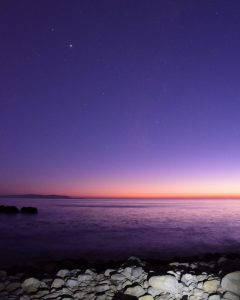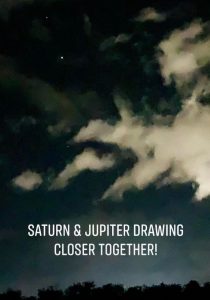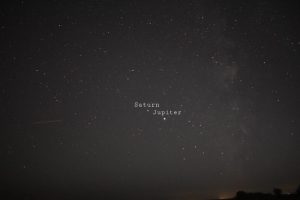Jupiter and Saturn, the two brightest gas giants, will have their once-in-20-years great conjunction on December 21, 2020.
Credits to Bruce McClure and Deborah Byrd in ASTRONOMY ESSENTIALS for pieces of this article.
Jupiter and Saturn come out first thing at nightfall in November 2020, and will continue to do so until the year’s end. They are near one another on the sky’s dome, with Saturn following Jupiter westward across the sky from nightfall until their setting below the southwest horizon.
At mid-northern latitudes, Jupiter and Saturn set at mid-evening; and from the Southern Hemisphere, they stay out till late night.
For the first time since the year 2000, Jupiter and Saturn will have a great conjunction this year, in December 2020. Great conjunctions of these two giant worlds happen every 20 years, but this year’s event will be the closest Jupiter-Saturn conjunction since the year 1623. Astronomers use the word conjunction to describe meetings of planets and other objects on our sky’s dome. They use the term great conjunction to describe a meeting of Jupiter and Saturn. The last great Jupiter-Saturn conjunction was May 28, 2000. The next one will be December 21, 2020. Watch for these worlds to edge closer and closer together throughout November 2020.
These two worlds appear bright and beautiful throughout November. Day by day, they’ll sink a bit lower in the sky at sunset, and set sooner after dark.
If you have a telescope, it’s best to use it when Jupiter and Saturn are highest up for the night at nightfall. These two worlds will descend westward as evening deepens, so catch them early. Typically, the view of Jupiter’s four major moons and Saturn’s glorious rings through the telescope is sharper when these worlds are higher up than lower down. The thickness of the Earth’s atmosphere near the horizon tends to blur the view of Jupiter’s moons and Saturn’s rings.
Look first for brilliant Jupiter; Saturn is the bright object immediately to Jupiter’s east. Although Saturn is easily as bright as a 1st-magnitude star – as bright as the brightest stars in our sky – the ringed planet can’t compete with the the king planet Jupiter, which outshines Saturn by some 12 times. After all, Jupiter almost always ranks as the fourth brightest celestial object, after the sun, the moon and the planet Venus, respectively (although Mars temporarily reigned as the fourth-brightest celestial body – and Jupiter as the fifth-brightest – in October 2020).
Watch for the moon in the neighborhood of Jupiter and Saturn for several days, centered on or near November 19.

Randy Shetter in Palos Verdes, California, captured this photo

Gene Hettel in Calamba, Laguna, Philippines, captured this image

Aurelian Neacsu in Visina, Dambovita, Romania, captured this image
Please feel free to CONTACT US with any concerns, requests or questions.
